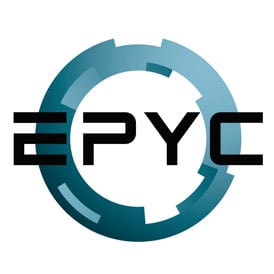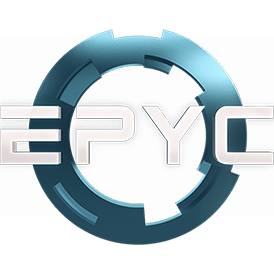AMD EPYC 7662 vs UNISOC T310
Last updated:
CPU comparison with benchmarks

|

|
|
| AMD EPYC 7662 | UNISOC T310 | |
CPU comparisonAMD EPYC 7662 or UNISOC T310 - which processor is faster? In this comparison we look at the differences and analyze which of these two CPUs is better. We compare the technical data and benchmark results.
The AMD EPYC 7662 has 64 cores with 128 threads and clocks with a maximum frequency of 3.30 GHz. Up to GB of memory is supported in 8 memory channels. The AMD EPYC 7662 was released in Q1/2020. The UNISOC T310 has 4 cores with 4 threads and clocks with a maximum frequency of 2.00 GHz. The CPU supports up to GB of memory in 0 memory channels. The UNISOC T310 was released in Q2/2019. |
||
| AMD EPYC (129) | Family | UNISOC 4G (10) |
| AMD EPYC 7002 (24) | CPU group | UNISOC 4G 12nm (8) |
| 2 | Generation | 0 |
| Rome (Zen 2) | Architecture | -- |
| Desktop / Server | Segment | Mobile |
| -- | Predecessor | -- |
| AMD EPYC 7763 | Successor | -- |
|
|
||
CPU Cores and Base FrequencyThe AMD EPYC 7662 is a 64 core processor with a clock frequency of 2.00 GHz (3.30 GHz). The UNISOC T310 has 4 CPU cores with a clock frequency of 2.00 GHz. |
||
| AMD EPYC 7662 | Characteristic | UNISOC T310 |
| 64 | Cores | 4 |
| 128 | Threads | 4 |
| normal | Core architecture | hybrid (big.LITTLE) |
| Yes | Hyperthreading | No |
| No | Overclocking ? | No |
| 2.00 GHz (3.30 GHz) | A-Core | 2.00 GHz 1x Cortex-A75 |
| -- | B-Core | 1.80 GHz 3x Cortex-A55 |
Integrated graphics (iGPU)The integrated graphics unit of a processor is not only responsible for the pure image output on the system, but can also significantly increase the efficiency of the system with the support of modern video codecs. |
||
| no iGPU | GPU | PowerVR GE8300 |
| GPU frequency | 0.80 GHz | |
| -- | GPU (Turbo) | -- |
| -- | GPU Generation | -- |
| Technology | 20 nm | |
| Max. displays | 1 | |
| -- | Compute units | 1 |
| -- | Shader | -- |
| No | Hardware Raytracing | No |
| No | Frame Generation | No |
| -- | Max. GPU Memory | 2 GB |
| -- | DirectX Version | 10 |
Hardware codec supportA photo or video codec that is accelerated in hardware can greatly accelerate the working speed of a processor and extend the battery life of notebooks or smartphones when playing videos. |
||
| no iGPU | GPU | PowerVR GE8300 |
| No | Codec h265 / HEVC (8 bit) | Decode |
| No | Codec h265 / HEVC (10 bit) | No |
| No | Codec h264 | Decode / Encode |
| No | Codec VP9 | No |
| No | Codec VP8 | No |
| No | Codec AV1 | No |
| No | Codec AVC | No |
| No | Codec VC-1 | No |
| No | Codec JPEG | No |
Memory & PCIeThe AMD EPYC 7662 supports a maximum of GB of memory in 8 memory channels. The UNISOC T310 can connect up to GB of memory in 0 memory channels. |
||
| AMD EPYC 7662 | Characteristic | UNISOC T310 |
| DDR4-3200 | Memory | , LPDDR4-1333, LPDDR3-933 |
| Max. Memory | ||
| 8 (Octa Channel) | Memory channels | 0 |
| 51.2 GB/s | Max. Bandwidth | -- |
| Yes | ECC | No |
| -- | L2 Cache | -- |
| 256.00 MB | L3 Cache | -- |
| 4.0 | PCIe version | -- |
| 128 | PCIe lanes | -- |
| 252.0 GB/s | PCIe Bandwidth | -- |
Thermal ManagementThe TDP (Thermal Design Power) of a processor specifies the required cooling solution. The AMD EPYC 7662 has a TDP of 225 W, that of the UNISOC T310 is --. |
||
| AMD EPYC 7662 | Characteristic | UNISOC T310 |
| 225 W | TDP (PL1 / PBP) | -- |
| -- | TDP (PL2) | -- |
| -- | TDP up | -- |
| -- | TDP down | -- |
| -- | Tjunction max. | -- |
Technical detailsThe AMD EPYC 7662 has a 256.00 MB cache, while the UNISOC T310 cache has a total of 0.00 MB. |
||
| AMD EPYC 7662 | Characteristic | UNISOC T310 |
| 7 nm | Technology | 12 nm |
| Chiplet | Chip design | Unknown |
| x86-64 (64 bit) | Instruction set (ISA) | Armv8-A (64 bit) |
| SSE4a, SSE4.1, SSE4.2, AVX2, FMA3 | ISA extensions | -- |
| SP3 | Socket | -- |
| AMD-V, SVM | Virtualization | None |
| Yes | AES-NI | No |
| Windows 10, Linux | Operating systems | Android |
| Q1/2020 | Release date | Q2/2019 |
| -- | Release price | -- |
| show more data | show more data | |
Rate these processors
Geekbench 5, 64bit (Single-Core)
Geekbench 5 is a cross plattform benchmark that heavily uses the systems memory. A fast memory will push the result a lot. The single-core test only uses one CPU core, the amount of cores or hyperthreading ability doesn't count.
|
|
AMD EPYC 7662
64C 128T @ 3.30 GHz |
||
|
|
UNISOC T310
4C 4T @ 2.00 GHz |
||
Geekbench 5, 64bit (Multi-Core)
Geekbench 5 is a cross plattform benchmark that heavily uses the systems memory. A fast memory will push the result a lot. The multi-core test involves all CPU cores and taks a big advantage of hyperthreading.
|
|
AMD EPYC 7662
64C 128T @ 2.40 GHz |
||
|
|
UNISOC T310
4C 4T @ 2.00 GHz |
||
Cinebench R20 (Single-Core)
Cinebench R20 is the successor of Cinebench R15 and is also based on the Cinema 4 Suite. Cinema 4 is a worldwide used software to create 3D forms. The single-core test only uses one CPU core, the amount of cores or hyperthreading ability doesn't count.
|
|
AMD EPYC 7662
64C 128T @ 3.30 GHz |
||
|
|
UNISOC T310
4C 4T @ 2.00 GHz |
||
Cinebench R20 (Multi-Core)
Cinebench R20 is the successor of Cinebench R15 and is also based on the Cinema 4 Suite. Cinema 4 is a worldwide used software to create 3D forms. The multi-core test involves all CPU cores and taks a big advantage of hyperthreading.
|
|
AMD EPYC 7662
64C 128T @ 2.40 GHz |
||
|
|
UNISOC T310
4C 4T @ 2.00 GHz |
||
iGPU - FP32 Performance (Single-precision GFLOPS)
The theoretical computing performance of the internal graphics unit of the processor with simple accuracy (32 bit) in GFLOPS. GFLOPS indicates how many billion floating point operations the iGPU can perform per second.
|
|
AMD EPYC 7662
@ 0.00 GHz |
||
|
|
UNISOC T310
PowerVR GE8300 @ 0.80 GHz |
||
Estimated results for PassMark CPU Mark
Some of the CPUs listed below have been benchmarked by CPU-monkey. However the majority of CPUs have not been tested and the results have been estimated by a CPU-monkey’s secret proprietary formula. As such they do not accurately reflect the actual Passmark CPU mark values and are not endorsed by PassMark Software Pty Ltd.
|
|
AMD EPYC 7662
64C 128T @ 2.40 GHz |
||
|
|
UNISOC T310
4C 4T @ 2.00 GHz |
||
Devices using this processor |
|
| AMD EPYC 7662 | UNISOC T310 |
| Unknown | Unknown |
Popular comparisons containing this CPUs
back to index



